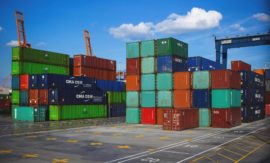Intended learning outcomes: Present the Supply Chain Operations Reference (SCOR) model. Describe levels 1 and 2 of the actual SCOR model.
Continuation from previous subsection (1.1.9).
Figure 1.1.9.1 shows the planning of the comprehensive supply chain as an ongoing synchronization of supply with demand in the comprehensive supply chain. The organizational units involved can be independent companies, or profit or cost centers within a company.
Fig. 1.1.9.1 Ongoing synchronization of supply with demand in the comprehensive supply chain.
This task is based on the internal chain of “source,” “make,” and “deliver” in each of the organizational units involved. All demand and capabilities of fulfilling them are carried by the network as a whole and reconciled jointly. Based on this idea, the Supply Chain Council (SCC), founded in 1996, merged with ASCM (the Association for Supply Chain Management) in 2014, published the Supply Chain Operations Reference model (SCOR®) (see also www.supply-chain.org).
SCOR, the Supply Chain Operations Reference model, is an aid to standardization of process chains within and across companies.
Figure 1.1.9.2 shows level 1 of the actual SCOR model.
Fig. 1.1.9.2 The SCOR model, version 12.0, level 1.
The aim of SCOR is to foster a common understanding of processes in the various companies participating in a supply chain. Figure 1.1.9.3 shows the six process categories and 30 reference processes defined by level 2 of the actual SCOR model.
Fig. 1.1.8.3 The 6 process categories and 32 reference processes of SCOR version 12.0, Level 2, toolkit.
The following animation allows examining the processes at level 3 of the SCOR model.
Course section 1.1: Subsections and their intended learning outcomes

1.1 Basic Definitions, Issues, and Challenges
Intended learning outcomes: Produce an overview on terms of the working environment and of business life. Explain service orientation in the classical industry, product orientation in the service industry, and the industrial product-service system. Disclose the product life cycle, the synchronization of supply and demand, and the role of inventories. Produce an overview on supply chain management, the role of planning and control as well as the SCOR model.

1.1.1 Work, Task, Process, Method, Object, etc. — Important Terms of the Working Environment
Intended learning outcomes: Produce an overview on terms of the working environment, such as work, task, function, order, procedure, process, method, object, business.

1.1.1b Value-Added, Business Process, Material, Product, etc. — Important Terms of Business Life
Intended learning outcomes: Produce an overview on terms of business life, such as value-added, business process, business method, business object, goods, item, part, component, material, product, artifact, management, etc.

1.1.2 Service and Servitization — Service Orientation in the Classical Industry
Intended learning outcomes: Present terms of the service domain such as service, customer service, service in the originary sense, servitization. Differentiate between a (primary, or core) product, a product in a broad sense, and a product in the most comprehensive sense.

1.1.3 The Service Industry and Industrialization of Service — Product Orientation in the Service Industry
Intended learning outcomes: Differentiate between service industry and classical (or conventional) industry. Produce an overview on industrialization of service.

1.1.4 The Industrial Product-Service System IPSS (or IPS2)
Intended learning outcomes: Present the industrial product-service system. Explain product-oriented, use-oriented, and result-oriented services as well as their degree of intangibility.

1.1.5 The Product Life Cycle: Design and Manufacturing, Service and Use, Recycling and Disposal
Intended learning outcomes: Differentiate between terms such as logistics, operations, logistic management, operations management, and value-added management.

1.1.5b Logistics, Operations, Logistics Management, Operations Management, and Value-Added Management
Intended learning outcomes: Differentiate between terms such as logistics, operations, logistic management, operations management, and value-added management.

1.1.6 The Customer Tolerance Time (or Demand Lead Time), and the Role of Inventories
Intended learning outcomes: Describe supply, demand, lead time, and customer tolerance time. Explain the problem of temporal synchronization between supply and demand as well as the role of various kinds of inventories in solving this problem.

1.1.7 Supply Chain, Extended Enterprise, and Supply Chain Management
Intended learning outcomes: Describe the reasons for logistics networks, production networks, procurement networks, distribution networks, and service networks. Produce an overview on the supply chain, the extended enterprise and supply chain management.

1.1.8 Circular Economy and Integral Logistics Management
Intended learning outcomes: Present circular economy and integral logistics management.

1.1.9 Supply Chain Planning and the Planning & Control System
Intended learning outcomes: Produce an overview on supply chain planning. Differentiate between production planning and control (PPC) and a PPC system.
